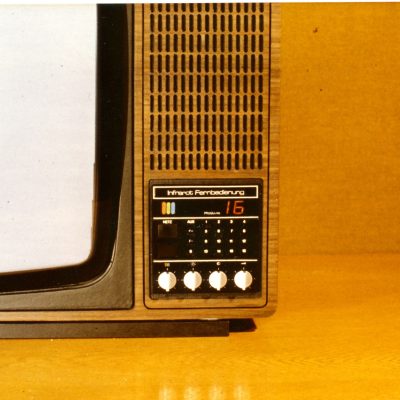Sales trip to Germany
Development director Aintila and designer Vaajakallio were sent to Germany in November-December 1975 to sell the project to Quelle. Those who left were reminded of the importance of the mission. Director Kaitera said: "We have to improve our skills and if we can sell to the Germans, we have enough quality for everyone else. If there is no deal, there is no point in you coming back here. The factory will be closed." It was accompanied by the model of a TV box, skilfully made by Finlux carpenter Esko Lehtonen and designed at Finlux to fit the imaginary world of Quelle's Universe.
”Wir sind Kunden und Sie sind Verkäufer. Hier sprechen wir Deutsch." "We are the customers and you are the salesmen. We speak German here." This is how our host greeted us. Back then, it was considered offensive if the salesperson did not speak the language of the customer, and not all German customers could speak English. as an "old school man", German was not a problem for Ahti, but as I had studied German only for a few years, I was in trouble. I understood what was being said to me - after all, I had illustrated a series of German textbooks for school to finance my studies - but speaking was difficult for me. We were horrified but that helped us to function.
Of course, the model we introduced was not good enough. It also didn't fit in with the client's future collection line because the future collection hadn't been shown to us. "If the designer draws us a model that we like, then we can go out for a dinner. The designer will be assisted by our graphic designer". We were prepared for this, I had included the outer edges of the right end of the TV's facade, where it was handy to design/draft the control unit and speaker grille. The client's designer knew the outlines of their future design, but he had probably been forbidden to talk about it. I had to guess. The designer made some sketches and every time we were close to the finish line, the client's designer would say: “Hotter, hotter.” This was a way to get into the customer's design world.
The problem was when the customer wanted a two-piece "control unit" with the IR receiver and channel number in a separate housing. It was outside our price range. "Don't think that we are prepared to pay any extra." So, the designer had to reduce the manufacturing price of the TV box by an extra piece of plastic, or he would not be allowed to eat or make a deal.
At that time, technology had brought the fax machine, which allowed drawings to be sent over a telephone line. The designer had arranged with Seppo Halminen, technical director of Salon Radiolaatikko, to be on duty next to his fax machine. I wrote on the address label: "Seppo, if we make a speaker grille in this new way, will we save two marks. Without that saving, we won't get the deal." Seppo did not promise me two marks, maybe one. That was enough, as I estimated the cost of an extra piece of plastic at 50 pennies. When the photo was ready, the client's manager arrived. ”Nicht böser. Wir bestellen 10 000 Stück” which meant that they will order 10 000 of them! That's 10 000 colour televisions every year! Ahti rushed to tell the good news. Hannele Lemmetty, secretary to the director of Kaitera, said that the director could not come to the phone "because celebrating when the ten thousandth television is ready.”

